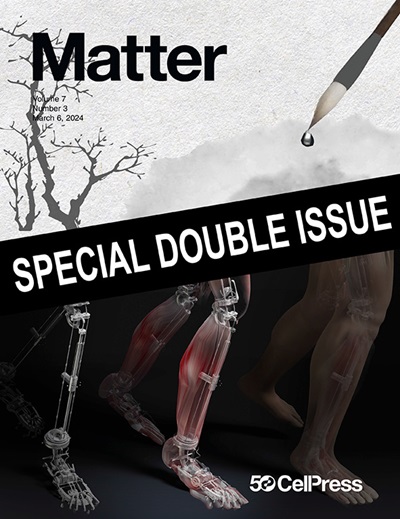分层多孔肌肽-锌微球
IF 17.5
1区 材料科学
Q1 MATERIALS SCIENCE, MULTIDISCIPLINARY
引用次数: 0
摘要
分层多孔材料在生物技术和医学中有着广泛的应用,但目前的制备方法往往缺乏可扩展性和生物相容性。在这里,我们提出了一种肽配位自组装方法来制备由天然存在的肌肽二肽和配位锌(II)离子组成的分层多孔微球。金属配位导致微球形成,具有相互连接的通道和分层多孔结构。通过扫描电子和透射电子显微镜以及扩展的x射线吸收精细结构表征,证实了其纳米纤维结构和局部Zn(II)配位环境。液体细胞透射电子显微镜,反过来,提供了实时洞察组装过程,揭示了从纳米团簇到纳米纤维,最终到多孔微球的逐步过程。肌肽-锌(II)微球具有固有的蓝色荧光和高孔隙率,包含微孔和介孔,有利于高效的质量运输和生物分子固定化。我们利用这些特性来产生可重复使用的,无细胞合成纳米反应器,以增强DNA转录和翻译,并防止核酸酶降解。本文章由计算机程序翻译,如有差异,请以英文原文为准。


Hierarchically porous carnosine-Zn microspheres
Hierarchically porous materials have broad applications in biotechnology and medicine, yet current fabrication methods often lack scalability and biocompatibility. Here, we present a peptide-coordination self-assembly approach to prepare hierarchically porous microspheres composed of naturally occurring carnosine dipeptide and coordinated Zn(II) ions. Metal coordination led to microsphere formation featuring interconnected channels with a hierarchically porous structure. Characterization with scanning electron and transmission electron microscopy, as well as with extended X-ray absorption fine structure, confirmed its nanofibrous architecture and local Zn(II) coordination environment. Liquid cell transmission electron microscopy, in turn, provided real-time insight into the assembly process, revealing a stepwise process from nanoclusters to nanofibers and ultimately to porous microspheres. The carnosine-Zn(II) microspheres exhibit intrinsic blue fluorescence and high porosity, containing both micropores and mesopores, which facilitate efficient mass transport and biomolecule immobilization. We leverage these properties to generate reusable, cell-free synthesis nanoreactors, to enhance DNA transcription and translation and protect against nuclease degradation.
求助全文
通过发布文献求助,成功后即可免费获取论文全文。
去求助
来源期刊

Matter
MATERIALS SCIENCE, MULTIDISCIPLINARY-
CiteScore
26.30
自引率
2.60%
发文量
367
期刊介绍:
Matter, a monthly journal affiliated with Cell, spans the broad field of materials science from nano to macro levels,covering fundamentals to applications. Embracing groundbreaking technologies,it includes full-length research articles,reviews, perspectives,previews, opinions, personnel stories, and general editorial content.
Matter aims to be the primary resource for researchers in academia and industry, inspiring the next generation of materials scientists.
 求助内容:
求助内容: 应助结果提醒方式:
应助结果提醒方式:


